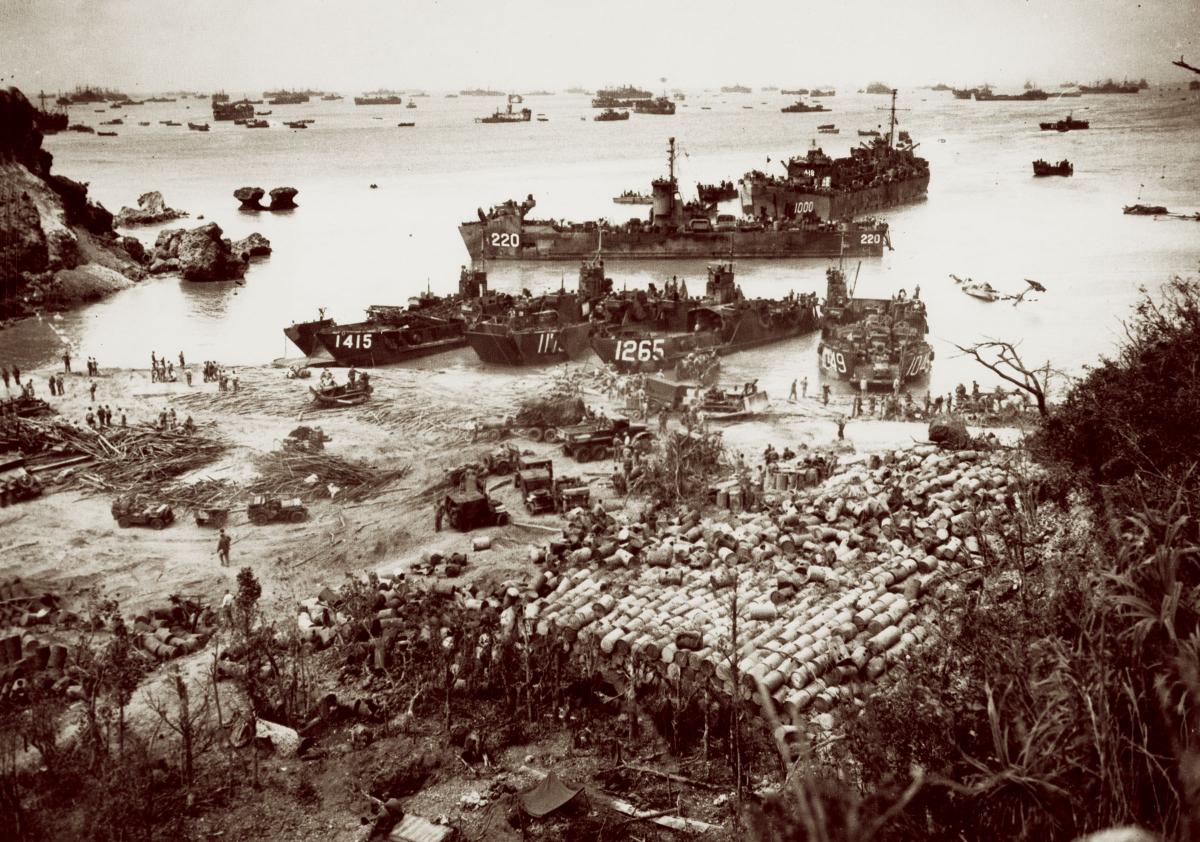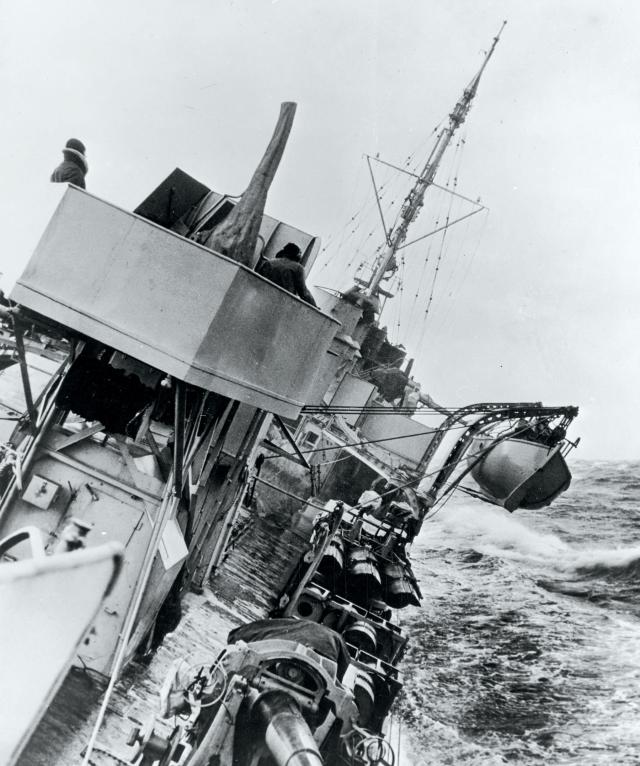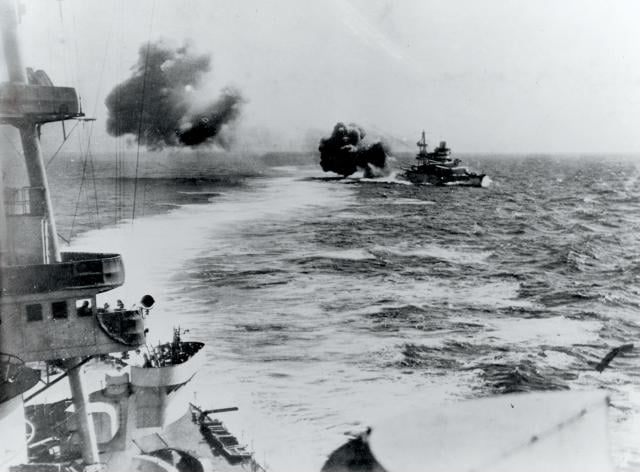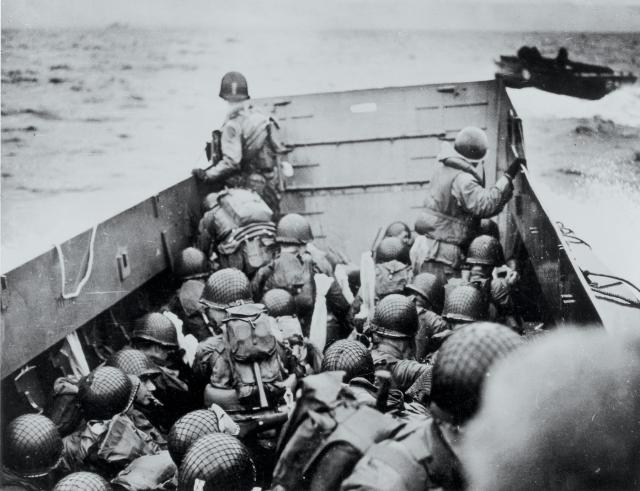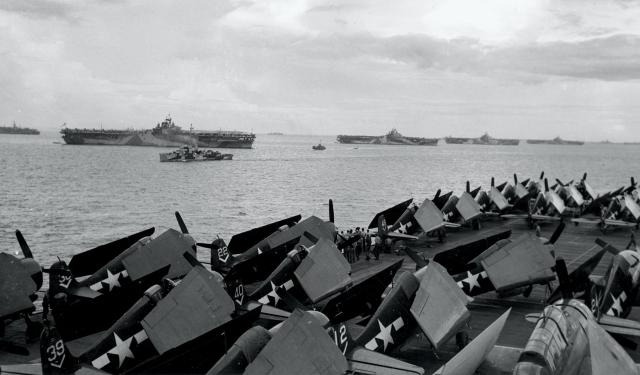Seventy-five years ago, in August 1945, the greatest naval war ever fought came to an end. World War II at sea was unequaled in terms of geographic extent, forces involved, and impact on the art and science of naval warfare. The story of this six-year-long struggle undoubtedly teaches many lessons, but from the perspective of 75 years, it also is true that events that once seemed important have lost significance; interpretations once considered canon are being reconsidered.1
For example, did Britain nearly lose the Battle of the Atlantic? In the 1970s, a prominent historian wrote, “It is a matter of history now how close the Allies came to defeat in the Atlantic during the first three months of 1943.”2 Today, however, most historians regard this campaign with a cooler eye and agree that the situation was never so dire.Distance has diminished passion and permits a more nuanced perspective.
The recent publication of several panoramic one-volume histories of the naval war reflects this tendency toward reflection and the integration of multiple perspectives.3 In a similar spirit, this article paints the naval war in broad strokes by suggesting it can be considered according to national goals, geography, and participation, and in terms of actions taken or not taken by the combatants.
Sea Victory = Total Victory?
Naval historians agree that the sea war was crucial; many assert the war was won on the oceans, or, at the least, that victory at sea enabled victory on land. “While ‘boots on the ground’ were essential . . . it was supremacy at sea that eventually proved decisive.” Or, “The remarkable military capabilities of Germany and Japan could not have been contained, and eventually crushed without Allied command of the seas.”4 This is the Anglo-American perspective, but every major combatant individually, and every coalition collectively, had different relationships with the sea; each had unique goals that were also dynamic as alliances, force structures, and geography shifted, sometimes dramatically. Every major combatant fought for different reasons, and their naval accomplishments (and failures) are best considered within the context of their own goals and capabilities, not just from the perspective of the Anglo-American victors.
All major naval powers operated under constants: They needed to transport matériel and men, defend their own interests, and interfere with the enemy. All were constrained by a limited supply of shipping and warships, by the need for men to operate these forces effectively, by the technology to operate them competitively, and, finally, by the fuel to operate them at all. It is surely a paradox that Germany, Italy, Japan, and France lacked enough fuel to freely operate their major warships—the most expensive individual weapons in their national warfighting inventories—for much of their naval war. By 1942, the Italians were even conducting firing exercises with ships tied to buoys. The Anglo-Americans occasionally had to limit operations because of local fuel shortages, but overall, their abundant supply of energy was a tremendous advantage.
The essence of sea power in World War II was the routine passage of a transport vessel from Point A to Point B; and its ultimate expression was the passage of a loaded amphibious transport from Point A to a hostile Point C, and the subsequent reinforcement of Point C. This required control of adjoining waters.
The flip side of control was denial, wherein a naval power disputed waters that it could not directly control by attacking enemy traffic or harassing enemy operations. Thus, the entire sea war consisted of offensive or defensive actions undertaken to assert or deny control of oceanic or littoral waters according to economic, military, and political requirements. Within this broad definition, actions can be categorized into certain generalized missions:
- Traffic War: An offensive/defensive mission wherein one naval power tried to interfere with or blockade another’s maritime traffic. Defensively, the mission was to protect friendly lines of communication. Examples include Axis efforts against Allied traffic to the United Kingdom (the Battle of the Atlantic), British efforts to stop Axis traffic between Europe and Africa, or the four-year campaign for transit rights through the English Channel.
- Decisive Battle: An offensive mission where one naval power attempted to gain a decisive advantage over another in a single clash. Examples include the July 1940 Battle of Calabria in the Mediterranean or the Pacific battles of Midway, the Philippine Sea, and Leyte Gulf.
- Amphibious Invasion/Evacuation: In the offensive aspect of this mission, one naval power landed and sustained a force of at least regimental size on a hostile shore. All the major naval powers except Italy and France conducted successful amphibious operations. The Allied assault landings at Normandy in June 1944 constituted the single most decisive naval event of the war. The May 1940 rescue of hundreds of thousands of troops from Dunkirk to England was the evacuation with the greatest military consequence.
- Raids/Bombardments: An offensive mission that could range from fleet incursions—Japanese carriers in the Indian Ocean in April–May 1942, U.S. fast carriers rampaging off the coast of Japan in 1945—to pinpricks such as the British destruction of fish-processing factories in Norway. Such actions served to harass the enemy and often had political as well as military objectives.
- Fleet in Being: A defensive mission wherein one naval power maintained a powerful strike force ready to intervene in waters normally disputed or controlled by another power. Examples include the German fleet in northern Norway between 1942 and 1944, the Italian fleet in 1942–43, or the French High Seas Force from 1940 to 1942.
Nearly every naval action undertaken in World War II can fit into one of these broad categories. (Training missions are an important exception.) The objective of every action was to exercise power at sea. Each nation approached sea power in accordance with its geographic situation, economic requirements, historical experience of naval warfare, and the force structure with which it started the war and to which it could add.
National Imperatives and Naval Strategies
For example, Japan shaped its naval strategy and its naval forces to fit an understanding of sea power that had been shaped by victories in the 1894 Battle of the Yalu River and the 1905 Battle of Tsushima Strait. Throughout the war, from Pearl Harbor to Okinawa, Japan’s naval strategy sought to engineer such a victory. In this quest, the Imperial Japanese Navy failed to fully undertake other important work, such as systematically attacking Allied supply lines in the Pacific or Indian Oceans, or effectively protecting its own traffic.
Germany gambled it could win the war on the Russian steppes and that it was unnecessary to directly confront British sea power in the English Channel by invading England in the fall of 1940 (or, more realistically, in the spring of 1941). This turned out to be a losing bet. Germany’s ability to project power overseas, even narrow littoral waters, proved inadequate—the landings in Norway turning out to be an anomaly rather than a consistent capability. Following this choice, Germany concluded its most important naval task was to attack Allied traffic—a strategy that likewise built on its naval experiences in World War I and its lack of a sufficiently powerful surface fleet to meaningfully pursue other strategies. As the war developed, Germany’s greatest naval task evolved into protection of its continental coastlines against Anglo-American invasion—a task that concrete fortifications and panzer reserves repeatedly failed to accomplish.
Italy’s major naval imperative was the protection of its long coastline and the maintenance of its critical sea lanes to Africa and the Balkans. Its greatest offensive requirement was to close the Mediterranean to routine British traffic, a task simplified by geography and adequate air and sea forces. Up through the Axis loss of Tunisia in May 1943, Italy’s naval war was successful in terms of its larger strategic goals. Even in defeat, the presence of a powerful navy helped Italy engineer the survival of both the government and much of the fleet despite the Allied objective of unconditional surrender.
Prior to June 1940, the French Navy’s major tasks were to blockade Germany, threaten Italy, and protect maritime communications between the Métropole and the empire. After the Franco-German armistice, the protection of traffic became a critical task for the navy of France, as half the calories consumed by its unhappy populace arrived from overseas. Indeed, the French fleet in being from June 1940 to November 1942 served as much a political as a military function and was a main reason for the French state’s continued existence despite Axis occupation of most of the Métropole and imprisonment of more than a million Frenchmen as hostages to enforce compliance with the armistice’s terms.
The maritime capabilities of the Soviet Union were greatly affected by geography—having four distinct and largely separate areas of operation (Black Sea, Baltic Sea, Arctic, Pacific)—and by events, particularly the loss of most Baltic bases, warships, and shipping in the war’s first weeks. Soviet sea power was expressed mainly through support of the army’s maritime flanks. The Soviets conducted several regimental and divisional landings in the Black Sea in 1941–42, in the Baltic in 1944, and in the Pacific in 1945. The Soviet Navy also supported the flow of critical supplies from the Western Allies. The Arctic convoys into Murmansk have received considerable attention from Anglo-American historians, but accounted for only 22.7 percent of deliveries. Cargoes arriving at Vladivostok from across the Pacific, mostly on Soviet ships, amounted to 47.1 percent of the total. As a prominent Russian historian has expressed it, “The importance of Lend-Lease cargoes, and therefore of the navies also, was enormous.”5
Given the experiences of World War I, the policy of Britain’s navies (including the Canadian, Australian, New Zealand, and Indian services) emphasized the defense of traffic and imperial connections, based in part on a global network of naval bases. Warship design and prewar construction reflected this policy. For example, at 20 knots, a new King George V battleship consumed 15 tons of fuel oil per hour, compared with 10.5 for the contemporary USS Washington (BB-56). When HMS King George V and the Washington operated together in 1942, the British admiral complained that the U.S. ship had double his vessel’s endurance.6
Another example was a requirement for a large number of small cruisers to patrol the British Empire’s global sea lanes. The United Kingdom avoided defeat in 1940, however, by maintaining sufficient potential control over the English Channel to discourage Germany from even attempting an invasion. Imperial defensive strategy and force structure proved inadequate when facing an opponent such as Japan, as the loss of HMS Prince of Wales and Repulse to Japanese land-based torpedo bombers in 1941 demonstrated. When called to the offensive against Japan in 1945, the Royal Navy played a minor role due to ships of limited range and undeveloped logistic forces. It did not possess the tools to exert sea power at the highest level in the post-colonial environment. On the other hand, the British rose to the offensive challenge of amphibious warfare, and the empire’s navies did play the larger part in the invasion of Normandy in June 1944.
The United States was the greatest maritime power of all on the basis of the strongest forces, the best technology, and the deepest reserves of quality personnel. Its basic naval requirement was the deployment of armies over oceanic distances while American production enriched its allies. The U.S. Navy started the war in a position of material strength that only got better, despite some bitter and costly defeats. In the war’s first year, the U.S. Navy focused on the Pacific, practicing a raiding strategy while maintaining a forward defense of the sea lanes from North America to Australia. In the Atlantic, it supported the larger effort of the British and Canadian navies. While the Anglo-Americans secured the sea lanes to Europe in the spring of 1943, U.S. efforts concentrated on an ever-expanding series of amphibious landings in Africa, Europe, and the Pacific—landings that grew in size from divisional to corps to armies.
The War’s Major Periods
Variables that greatly affected the naval war were geography and participation. While the entire world ocean was a potential battle zone, in practical terms, the Pacific became active after Japan entered the war against the Western Allies in December 1941. The participation of Italy in the Axis lasted 39 months, from June 1940 to September 1943, and the Mediterranean was most active militarily during that time. Only the British Empire participated in the entire course of the war in nearly all areas where it was fought (the Baltic and Black Sea are exceptions). The naval war, in fact, can be divided into four periods based on geography and participation:
1. September 1939 to the fall of France in June 1940. During this period, the British and French navies blockaded Germany and easily smothered enemy efforts to attack their oceanic and domestic traffic. The biggest naval event was Germany’s amphibious coup de main against Norway, accomplished with great daring although at the cost of much of the fleet. This event transformed Europe’s naval geography by giving Germany North Atlantic bases and securing for it control of Baltic and Scandinavian resources, particularly Swedish iron ore. It also guaranteed safe waters for the meticulous training practiced by the Kriegsmarine. The evacuation of Dunkirk was a naval event with enormous consequences in sustaining the United Kingdom’s belligerency.
This period ended in June 1940 when the Italian Navy became an active participant and cut Britain’s important imperial sea route through the Mediterranean. The French fleet was weakened and became a hostile neutral with respect to the Allies while remaining uncooperative with the Axis. The German occupation of France’s Atlantic coast was another major geographical transformation.
2. The fall of France to the intervention of Japan in December 1941. In the Mediterranean, the British first sought to win a decisive naval victory based on the policy that Italy was the weaker Axis participant and could be driven from the alliance with a sharp naval defeat. The July 1940 Battle of Calabria, however, failed to shake Italian morale as hoped and led the British to adopt a strategy of attrition against Axis traffic while maintaining forward bases at Gibraltar and Malta. In the Atlantic, the Germans continued their war on traffic with increasing but still minor effect.
As noted, Berlin failed to realistically prepare an amphibious invasion of Britain, as Adolf Hitler did not believe the risk, difficulty, and cost of such an action—even if it presented the best chance to defeat the United Kingdom—was worth delaying other priorities such as attacking Russia. Even worse, Germany did little to maintain a credible threat of invasion and suspended air attacks on English west-coast ports. The Kriegsmarine did not test its apparent superiority in the Baltic to assist the army’s advance into the Soviet Union.
During this time, the British pursued a colonial naval war against the French in Africa and Syria and followed a pinprick raiding strategy against Axis targets in Norway and the Mediterranean. The most famous naval event was the sinking of the German battleship Bismarck by the British Home Fleet. New technology such as radar began to be applied with still minor effect. The potential of air power revealed itself in European waters as aircraft demonstrated the ability to sink major ships under way and even to assert sustained sea power directly, as in the waters off Crete in late May 1941, where Axis aircraft sank eight major warships and damaged another dozen, including a carrier and a pair of battleships.
Some of the peripheral naval campaigns conducted in this period, such as between France and Thailand in January 1941, or Peru and Ecuador in July 1941, await study.
3. From Pearl Harbor to September 1943 and the armistice with Italy. During this period, Axis naval power reached its apogee, and the coalitions fought major battles in the Pacific, Indian, Arctic, and Atlantic Oceans, and the Black and Mediterranean Seas.
Both sides practiced amphibious warfare on a large and growing scale. Japan’s conquest of Indonesia and the Philippines consisted of two dozen landings, from battalion- to division-sized, in just four months. The first Allied division-sized landings were by the Soviets in the Black Sea in December 1941 followed by the British in Madagascar in May 1942. Operation Torch, a multidivisional invasion from across the breadth of the Atlantic Ocean onto the coastlines of Morocco and Algeria, trumped this operation in November 1942.
The success of Torch deserves mention because it gave the Anglo-Americans not just the North African shore, but also what would prove to be an important tool for their victory: the ability to jointly plan and carry out combined (air/land/sea) operations. Torch also broke the deadlock in the Mediterranean, allowing Malta to be replenished and diverting Axis reinforcements from contesting the latest British advance into Cyrenaica that was about to begin following the Battle of El Alamein. The Allies effectively defeated Axis efforts to interdict their oceanic traffic in the spring of 1943, a watershed delayed by the need to tie up strong escort forces in Operation Torch.
The other major naval event during this period was the June 1942 Battle of Midway—the second and most consequential of the seven carrier battles fought between the U.S. and Japanese navies. Many historians say that aircraft carriers transformed naval warfare. This is true, but carriers also were fragile and very much hit-and-run weapons. Their impact also was expressed less dramatically but with equal importance by the escort carriers that accompanied convoys and kept submarines away and that played an important role in the success of most major landings from Torch forward.
4. From the armistice with Italy to war’s end. The September 1943 Armistice of Cassibile subtracted a major fleet from the Axis order of battle and again transformed the naval war’s geography. Although minor naval affairs continued in the Adriatic, Aegean, Tyrrhenian, and Ligurian Seas, supplies began flowing freely between Gibraltar and Suez, eliminating a major fishbone that had been choking British naval capabilities. In this period, the greatest naval failure again belonged to Germany, which could not repulse amphibious landings at Sicily in July 1943, Salerno in September 1943, Anzio in January 1944, Normandy in June 1944, or the Riviera in August 1944. These failures, particularly Normandy, secured Germany’s defeat in the West.
The U.S. campaign in the Pacific dominates the narrative of this period. First, the Americans concluded their long advance up the Solomon Islands with the November 1943 landings on Bougainville. In the wider Pacific, they advanced in two directions, through New Guinea and over the atolls of the Gilberts and Marshalls, applying sea power in massive doses against a determined and motivated opponent, and on to the Marianas and another victory in a decisive battle off Saipan in June 1944. The Americans then leapt all the way to the Philippines and won another crucial battle off Leyte in October 1944 and continued on to Luzon, Iwo Jima, and Okinawa in April 1945 with hardly a pause and without an important defeat.
Simultaneously with this dazzling display of sea power, U.S. forces clamped down on Japanese maritime traffic with submarines and high-tech mines largely delivered by heavy bombers. One is entitled to wonder whether Axis resistance could have been shortened if sea power had been applied in the same daring and breathless fashion in European waters after Operation Torch.
The Technological Edge . . .
When considering the naval war as a whole, several factors deserve special mention. The first is technology. The Allies improved their naval advantages with the integration of new technologies, particularly radar and communications, and the effective processing of information. Technology that might have been decisive for the Axis failed to play an important role. For example, German influence mines—available in useable numbers—could have transformed the Normandy invasion into a close-run thing, even a defeat, but the Germans failed to deploy this weapon effectively. Germany had the best radar afloat in 1939 but failed to keep pace with the Anglo-Americans in its development and use. By 1945, the most important electronics on German vessels were their radar detection gear. French warships that joined the Allies in late 1942, intact and with experienced crews, still needed American shipyards to install radar and better antiaircraft weapons and fire-control systems before they were considered fit to serve with the Anglo-American first string.
Another factor that contributed to Allied naval success was the ability to rapidly expand forces with quality men and matériel. The USS Massachusetts (BB-59) was launched in September 1941 and commissioned less than eight months later with a 70-percent draftee crew. Of the ship’s 113 officers, only 19 had more than two years’ service and 22 had never been to sea. The ship successfully led the first U.S. offensive in European/African waters in November 1942, just 14 months after being launched. Compare this to the German battleship Tirpitz, launched in April 1939 and first used operationally in June 1941—26 months later.
. . . And the Intel Advantage
The knowledge that losses could be replaced was critical to the way the Anglo-Americans fought and their acceptance of risk. This was one of their great advantages over their Axis foes. Intelligence affected the naval war, with the advantage going sometimes to the Axis, sometimes to the Allies. Although enthusiastic claims have been made that Ultra signals intelligence shortened by war by two years, a close study shows that the Allied advantage conferred by Ultra, at least until 1943, was periodic and relatively minor. It is true, however, that over the course of the war the Allies reaped greater benefits from intelligence than did the Axis powers.
Evaluations of the naval war generally consider ships and weapons, but the men and the culture of a navy deserve attention. The traditional study of campaigns and battles helps gauge what navies considered important and how they accepted risk, but the ability to innovate and even improvise proved, over the course of the war, more important than higher muzzle velocities or thicker armor. Navies that shared information more effectively and were able to honestly assess their own performance made better decisions than those that exaggerated their accomplishments or downplayed their failures. This was another important Anglo-American advantage, especially compared with the Japanese, although the ability to absorb hard lessons was a factor in the way the Italian Navy improved its skills in 1942–43.
By 1945, the best naval warfare was a societal affair; an example is the way the U.S. Navy’s combat information center developed independently on an individual ship and then spread up throughout the fleet. (The action information office in the Royal Navy provides a similar example.) For examples of informative clarity, training manuals produced by the U.S. Navy on most any subject are hard to beat. In a similar way, the study of this period’s history has been democratized by the widespread availability of archival information in internet sources and by a range of tools for dealing with material in other languages that the historian of a generation before had no access to. The story of the war at sea in World War II is still being told in new and interesting ways, even after 75 years.
1. See Richard B. Frank, Tower of Skulls: A History of the Asia-Pacific War, July 1937–May 1942 (New York: W. W. Norton & Company, 2020). Frank dates the naval war from the Japanese attack on Shanghai in 1937. Others, such as the Italian historian Enrico Cernuschi, consider the naval war to have started with the Spanish Civil War in 1936.
2. Peter Kemp, Decision at Sea: The Convoy Escorts (New York: Elsevier-Dutton, 1978), 105.
3. Craig Symonds, World War II at Sea: A Global History (New York: Oxford University Press, 2018); Evan Mawdsley, The War for the Seas: A Maritime History of World War II (New Haven, CT: Yale University Press, 2019).
4. Symonds, World War II at Sea, 641. Mawdsley, The War for the Seas, 478.
5. V. D. Dotsenko, Flot – Voina – Pobeda 1941–1945 (St. Petersburg, Russia: Sudostroenie, 1995), 21. Translation courtesy of Stephen McLaughlin.
6. D. K. Brown, Nelson to Vanguard: Warship Design and Development 1923–1945 (Annapolis, MD: Naval Institute Press, 2006), 33.



